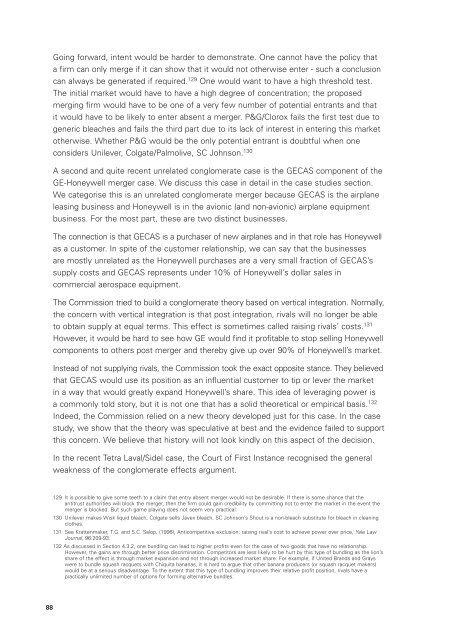Bundling, Tying, and Portfolio Effects: Part 1 Conceptual Issues
Bundling, Tying, and Portfolio Effects: Part 1 Conceptual Issues
Bundling, Tying, and Portfolio Effects: Part 1 Conceptual Issues
You also want an ePaper? Increase the reach of your titles
YUMPU automatically turns print PDFs into web optimized ePapers that Google loves.
Going forward, intent would be harder to demonstrate. One cannot have the policy that<br />
a firm can only merge if it can show that it would not otherwise enter - such a conclusion<br />
can always be generated if required. 129 One would want to have a high threshold test.<br />
The initial market would have to have a high degree of concentration; the proposed<br />
merging firm would have to be one of a very few number of potential entrants <strong>and</strong> that<br />
it would have to be likely to enter absent a merger. P&G/Clorox fails the first test due to<br />
generic bleaches <strong>and</strong> fails the third part due to its lack of interest in entering this market<br />
otherwise. Whether P&G would be the only potential entrant is doubtful when one<br />
considers Unilever, Colgate/Palmolive, SC Johnson. 130<br />
A second <strong>and</strong> quite recent unrelated conglomerate case is the GECAS component of the<br />
GE-Honeywell merger case. We discuss this case in detail in the case studies section.<br />
We categorise this is an unrelated conglomerate merger because GECAS is the airplane<br />
leasing business <strong>and</strong> Honeywell is in the avionic (<strong>and</strong> non-avionic) airplane equipment<br />
business. For the most part, these are two distinct businesses.<br />
The connection is that GECAS is a purchaser of new airplanes <strong>and</strong> in that role has Honeywell<br />
as a customer. In spite of the customer relationship, we can say that the businesses<br />
are mostly unrelated as the Honeywell purchases are a very small fraction of GECAS’s<br />
supply costs <strong>and</strong> GECAS represents under 10% of Honeywell’s dollar sales in<br />
commercial aerospace equipment.<br />
The Commission tried to build a conglomerate theory based on vertical integration. Normally,<br />
the concern with vertical integration is that post integration, rivals will no longer be able<br />
to obtain supply at equal terms. This effect is sometimes called raising rivals’ costs. 131<br />
However, it would be hard to see how GE would find it profitable to stop selling Honeywell<br />
components to others post merger <strong>and</strong> thereby give up over 90% of Honeywell’s market.<br />
Instead of not supplying rivals, the Commission took the exact opposite stance. They believed<br />
that GECAS would use its position as an influential customer to tip or lever the market<br />
in a way that would greatly exp<strong>and</strong> Honeywell’s share. This idea of leveraging power is<br />
a commonly told story, but it is not one that has a solid theoretical or empirical basis. 132<br />
Indeed, the Commission relied on a new theory developed just for this case. In the case<br />
study, we show that the theory was speculative at best <strong>and</strong> the evidence failed to support<br />
this concern. We believe that history will not look kindly on this aspect of the decision.<br />
In the recent Tetra Laval/Sidel case, the Court of First Instance recognised the general<br />
weakness of the conglomerate effects argument.<br />
129 It is possible to give some teeth to a claim that entry absent merger would not be desirable. If there is some chance that the<br />
antitrust authorities will block the merger, then the firm could gain credibility by committing not to enter the market in the event the<br />
merger is blocked. But such game playing does not seem very practical.<br />
130 Unilever makes Wisk liquid bleach, Colgate sells Javex bleach, SC Johnson’s Shout is a non-bleach substitute for bleach in cleaning<br />
clothes.<br />
131 See Krattenmaker, T.G. <strong>and</strong> S.C. Salop, (1996), Anticompetitive exclusion: raising rival’s cost to achieve power over price, Yale Law<br />
Journal, 96:209-93.<br />
132 As discussed in Section 4.3.2, one bundling can lead to higher profits even for the case of two goods that have no relationship.<br />
However, the gains are through better price discrimination. Competitors are less likely to be hurt by this type of bundling as the lion’s<br />
share of the effect is through market expansion <strong>and</strong> not through increased market share. For example, if United Br<strong>and</strong>s <strong>and</strong> Grays<br />
were to bundle squash racquets with Chiquita bananas, it is hard to argue that other banana producers (or squash racquet makers)<br />
would be at a serious disadvantage. To the extent that this type of bundling improves their relative profit position, rivals have a<br />
practically unlimited number of options for forming alternative bundles.<br />
88

















